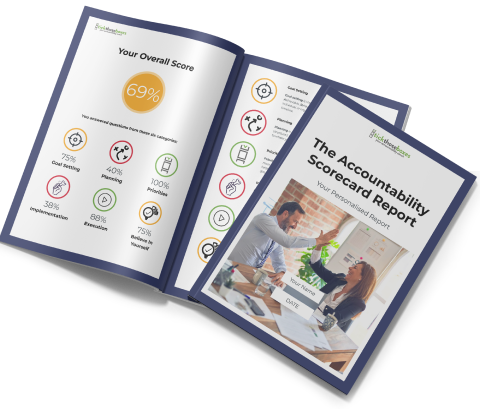Navigation
Learn More
Contact
- +61 418 379 369
- df@tickthoseboxes.com.au
-
P.O Box 282
Caulfield South. Vic 3162
Australia - Contact Form
Social Media

Posted on: 13/05/2024

Employees are the backbone of any organization, helping it stay afloat in all situations. As a business leader, your goal should be to get the most out of them. However, that requires tracking their performance regularly and informing them about their shortcomings. Today, 82% of managers admit they’re not adequately equipped to hold their employees accountable.
But how can you tell if your employees are performing optimally? How do you determine if they’re working harder or smarter? We’ll answer these and many other pertinent questions regarding performance accountability in this write-up.

Discover your Accountability Score and increase the probability of smashing your GOALS and Getting Sh!t Done!
Employee performance simply means to what extent an employee is fulfilling their duties, upholding organizational standards, and meeting deadlines. It includes the work’s quality, quantity, and efficiency with which an employee performs it.
Measuring employee performance matters because it tells you where your company stands. As a result, you are well-positioned to make future projections and take measures that improve your business. However, measuring performance and holding employees accountable also ensures they reach their full potential.
Here are some of the best tips to hold your employees accountable.
Setting clear objectives is a no-brainer when it comes to measuring the performance of your employees and holding them accountable. After all, how can you hold them responsible if you have no defined goals or objectives? The most effective way to do it is to set specific goals against each member’s name so that you can track them accordingly.
Before setting these objectives, it is crucial to consult the employees and answer their questions. It helps them understand the goals to ensure there is no confusion down the line.
While your employees and team members might give their 100%, they might still not meet your expectations. That is why it is crucial to provide regular feedback and help them improve.
You can hold one-on-one performance reviews to let every employee know how well they are doing and where they can improve. The SMART method can be pretty valuable here, which stands for:
Doing performance accountability using this framework gives you a holistic picture of your organization.
Fairness and consistency in performance accountability are essential elements of effective leadership. Regardless of their position or tenure, all employees must be held to the same standards for efficiency and conduct. It helps you reduce biases and favoritism in your approach and ensures consistency in accountability.
As a leader, your job should be to ensure your team performs optimally by consistently achieving its targets. For that, support in the form of knowledge and resources is critical. It helps employees enhance their skill level, build confidence, and take ownership of their work.
It is essential to provide them with the necessary support at every step to minimize the chances of failure. That’s crucial because if the employees feel they won’t succeed, they will likely blame outside factors. It leads to an unending blame game without anyone holding themselves accountable.
Competency means a certain level of skill required to perform a task and achieve a desired output level. While competencies are used for recruitment and selection, they are also highly valuable for performance accountability.
When measuring performance, competencies usually revolve around specific task requirements, behaviors, and attitudes as part of a role within an organization. Once you have crafted a comprehensive competency framework, you can evaluate your employees using it.
If an employee’s poor performance continues unaddressed, it leads to bigger problems for them and the organization. Most often, leadership blames it on the lack of responsibility on behalf of the employee.
However, that is not always the case. Some of the other reasons that could contribute to poor performance are:
If an employee’s performance isn’t up to the mark, you should also ask yourself the following questions:
Tips | Description |
Set Clear Objectives | Setting well-defined objectives helps make your performance accountability accurate. |
Provide Regular Feedback | Regular feedback keeps your employees on track toward achieving the targets. |
Stay Fair and Consistent | Fairness in accountability helps you avoid biases and favouritism. |
Resources | Providing knowledge and resources ensures that employees have the much-needed technical support throughout. |
Using Behavioural Competencies | A competency framework helps you measure performance with behavioural aspects of employees. |
Addressing Poor Performance Upfront | Addressing poor performance quickly ensures that you catch the problematic factors and address them without wasting any time. |
Performance accountability is a complex arena with multiple dynamics, including robust guidelines, regular feedback, providing adequate resources, and much more. If you get it right, your employees and organization both thrive. If not, you’ll follow consistent setbacks.
Hence, it is crucial to have guidance from a professional. If you need assistance you can take a look at my accountability coaching packages or take an accountability assessment.
Contact me today and let me guide you through this journey.

Darren Finkelstein, The Accountability Guy®, is the founder of TICK THOSE BOXES, a specialised accountability coaching practice. Darren is a formidable international accountability coach, business advisor, mentor, and author/speaker, fostering development and measurable results in entrepreneurship, leadership, and accountability. Darren’s tale is one of perseverance, self-reinvention, and resilience.
With compelling execution, Darren has empowered high-achieving individuals and teams from Australia and New Zealand to Latin America, Europe, Asia, the UK, and the US to embrace accountability; after all, it is your superpower.
Darren’s one-on-one and group coaching programs are based on his bestselling business book, “The Accountability Advantage – Play your best game” and the latest, release “NO’ – Building a life of choice without obligation”.
Darren has an impressive background in business, having held the role of “Manager of Commercial Markets” at Apple Australia during the Steve Jobs revolution.
He enthusiastically “walks the talk,” having also successfully sold and exited his lifestyle businesses, which served as the impetus for establishing his coaching and mentoring business.
Join Darren on this transformative quest to accomplish the remarkable.
Read Darren’s full bio here:
https://tickthoseboxes.com.au/about/

Know what to do first

know what to do next

know what to do more of
Navigation
Learn More
Contact
Social Media
© 2025 TickThoseBoxes® | Privacy Policy | Terms and Conditions
I was excited to join Tia Harmer on The Work in Progress: The Personal Productivity Science Insights Podcast! We dive deep into the science of goal setting and the power of accountability—two cornerstones of business and personal success.